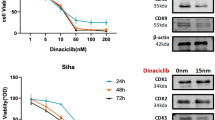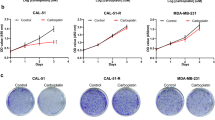Abstract
Radiation therapy (RT) is one of the main treatment modalities for cervical cancer. Rosiglitazone (ROSI) has been reported to have antiproliferative effects against various types of cancer cells and also to induce antioxidant enzymes that can scavenge reactive oxygen species (ROS) and thereby modify radiosensitivity. Here, we explored the effect of ROSI on radiosensitivity and the underlying mechanisms in cervical cancer cells. Three cervical cancer cell lines (ME-180, HeLa, and SiHa) were used. The cells were pretreated with ROSI and then irradiated. Expression of proteins of interest was detected by western blot and immunofluorescence. Intracellular production of ROS was measured by H2DCFDA. Radiosensitivity was assessed by monitoring clonogenic survival. Expression of antioxidant enzymes (catalase, superoxide dismutases) was increased by ROSI in HeLa and SiHa cells, but not in ME-180 cells. With ROSI pre-treatment, cell survival after irradiation remained unchanged in HeLa and SiHa cells, but decreased in ME-180 cells. Radiation-induced expression of γ-H2AX was increased and that of RAD51 was decreased by ROSI pre-treatment in ME-180 cells, but not in HeLa cells. ROSI increases radiosensitivity by inhibiting RAD51-mediated repair of DNA damage in some cervical cancer cell lines; therefore, ROSI is a potential inhibitor of RAD51 that can be used to enhance the effect of RT in the treatment of some cervical cancers.




Similar content being viewed by others
References
Abdulkarim B, Sabri S, Deutsch E, Chagraoui H, Maggiorella L, Thierry J, Eschwege F, Vainchenker W, Chouaib S, Bourhis J (2002) Antiviral agent Cidofovir restores p53 function and enhances the radiosensitivity in HPV-associated cancers. Oncogene 21:2334–2346
Aebi H (1984) Catalase in vitro. Methods Enzymol 105:121–126
Alagpulinsa DA, Ayyadevara S, Shmookler Reis RJ (2014) A small-molecule inhibitor of RAD51 reduces homologous recombination and sensitizes multiple myeloma cells to doxorubicin. Front Oncol 4:289
An Z, Liu X, Song H, Choi C, Kim WD, Yu JR, Park WY (2012) Effect of troglitazone on radiation sensitivity in cervix cancer cells. Radiat Oncol J 30:78–87
An Z, Muthusami S, Yu JR, Park WY (2014) T0070907, a PPAR gamma inhibitor, induced G2/M arrest enhances the effect of radiation in human cervical cancer cells through mitotic catastrophe. Reprod Sci 21:1352–1361
Banath JP, Klokov D, MacPhail SH, Banuelos CA, Olive PL (2010) Residual gammaH2AX foci as an indication of lethal DNA lesions. BMC Cancer 10:4-2407-10-4
Chernikova SB, Game JC, Brown JM (2012) Inhibiting homologous recombination for cancer therapy. Cancer Biol Ther 13:61–68
Chiu SJ, Hsaio CH, Tseng HH, Su YH, Shih WL, Lee JW, Chuah JQ (2010) Rosiglitazone enhances the radiosensitivity of p53-mutant HT-29 human colorectal cancer cells. Biochem Biophys Res Commun 394:774–779
Choudhury A, Zhao H, Jalali F, Al Rashid S, Ran J, Supiot S, Kiltie AE, Bristow RG (2009) Targeting homologous recombination using imatinib results in enhanced tumor cell chemosensitivity and radiosensitivity. Mol Cancer Ther 8:203–213
Duenas-Gonzalez A, Serrano-Olvera A, Cetina L, Coronel J (2014) New molecular targets against cervical cancer. Int J Womens Health 6:1023–1031
Frohlich E, Wahl R (2015) Chemotherapy and chemoprevention by thiazolidinediones. Biomed Res Int 2015:845340
Greer BE, Koh WJ, Abu-Rustum NR, Apte SM, Campos SM, Chan J, Cho KR, Copeland L, Crispens MA, Dupont N, Eifel PJ, Gaffney DK, Huh WK, Kapp DS, Lurain JR 3rd, Martin L, Morgan MA, Morgan RJ Jr, Mutch D, Remmenga SW, Reynolds RK, Small W Jr, Teng N, Valea FA, National Comprehensive Cancer Networks (2010) Cervical cancer. J Natl Compr Cancer Netw 8:1388–1416
Hall EJ, Giaccia AJ (2012) Radiobiology for the radiologist. Lippincott Williams & Wilkins, USA
Jaworska A, Stojcevic-Lemic N, Nias AH (1993) The effect of paraquat on the radiosensitivity of melanoma cells: the role of superoxide dismutase and catalase. Free Radic Res Commun 18:139–145
Khoo NK, Hebbar S, Zhao W, Moore SA, Domann FE, Robbins ME (2013) Differential activation of catalase expression and activity by PPAR agonists: implications for astrocyte protection in anti-glioma therapy. Redox Biol 1:70–79
Kliewer SA, Umesono K, Noonan DJ, Heyman RA, Evans RM (1992) Convergence of 9-cis retinoic acid and peroxisome proliferator signalling pathways through heterodimer formation of their receptors. Nature 358:771–774
Kuo LJ, Yang LX (2008) Gamma-H2AX—a novel biomarker for DNA double-strand breaks. In Vivo 22:305–309
Liu Q, Jiang H, Liu Z, Wang Y, Zhao M, Hao C, Feng S, Guo H, Xu B, Yang Q, Gong Y, Shao C (2011) Berberine radiosensitizes human esophageal cancer cells by downregulating homologous recombination repair protein RAD51. PLoS One 6:e23427
Maacke H, Jost K, Opitz S, Miska S, Yuan Y, Hasselbach L, Luttges J, Kalthoff H, Sturzbecher HW (2000) DNA repair and recombination factor Rad51 is over-expressed in human pancreatic adenocarcinoma. Oncogene 19:2791–2795
Mishra P, Singh SV, Verma AK, Srivastava P, Sultana S, Rath SK (2014) Rosiglitazone induces cardiotoxicity by accelerated apoptosis. Cardiovasc Toxicol 14:99–119
Mladenov E, Magin S, Soni A, Iliakis G (2013) DNA double-strand break repair as determinant of cellular radiosensitivity to killing and target in radiation therapy. Front Oncol 3:113
Nogueira A, Assis J, Catarino R, Medeiros R (2013) DNA repair and cytotoxic drugs: the potential role of RAD51 in clinical outcome of non-small-cell lung cancer patients. Pharmacogenomics 14:689–700
Rezvani HR, Cario-Andre M, Pain C, Ged C, deVerneuil H, Taieb A (2007) Protection of normal human reconstructed epidermis from UV by catalase overexpression. Cancer Gene Ther 14:174–186
Smith PS, Zhao W, Spitz DR, Robbins ME (2007) Inhibiting catalase activity sensitizes 36B10 rat glioma cells to oxidative stress. Free Radic Biol Med 42:787–797
Somaiah N, Yarnold J, Daley F, Pearson A, Gothard L, Rothkamm K, Helleday T (2012) The relationship between homologous recombination repair and the sensitivity of human epidermis to the size of daily doses over a 5-week course of breast radiotherapy. Clin Cancer Res 18:5479–5488
Song L, Liu S, Zeng S, Zhang L, Li X (2015) miR-375 modulates radiosensitivity of HR-HPV-positive cervical cancer cells by targeting UBE3A through the p53 pathway. Med Sci Monit 21:2210–2217
Tennstedt P, Fresow R, Simon R, Marx A, Terracciano L, Petersen C, Sauter G, Dikomey E, Borgmann K (2013) RAD51 overexpression is a negative prognostic marker for colorectal adenocarcinoma. Int J Cancer 132:2118–2126
van Oorschot B, Hovingh SE, Moerland PD, Medema JP, Stalpers LJ, Vrieling H, Franken NA (2014) Reduced activity of double-strand break repair genes in prostate cancer patients with late normal tissue radiation toxicity. Int J Radiat Oncol Biol Phys 88:664–670
Wan XS, Zhou Z, Ware JH, Kennedy AR (2005) Standardization of a fluorometric assay for measuring oxidative stress in irradiated cells. Radiat Res 163:232–240
Wang L, Yu CJ, Liu W, Cheng LY, Zhang YN (2011) Rosiglitazone protects neuroblastoma cells against advanced glycation end products-induced injury. Acta Pharmacol Sin 32:991–998
Ward A, Khanna KK, Wiegmans AP (2015) Targeting homologous recombination, new pre-clinical and clinical therapeutic combinations inhibiting RAD51. Cancer Treat Rev 41:35–45
Welsh JW, Ellsworth RK, Kumar R, Fjerstad K, Martinez J, Nagel RB, Eschbacher J, Stea B (2009) Rad51 protein expression and survival in patients with glioblastoma multiforme. Int J Radiat Oncol Biol Phys 74:1251–1255
Wiegmans AP, Al-Ejeh F, Chee N, Yap PY, Gorski JJ, Da Silva L, Bolderson E, Chenevix-Trench G, Anderson R, Simpson PT, Lakhani SR, Khanna KK (2014) Rad51 supports triple negative breast cancer metastasis. Oncotarget 5:3261–3272
Author information
Authors and Affiliations
Corresponding author
Ethics declarations
Funding
This study was funded by the Chungbuk National University (2013) and National Research Foundation of Korea (2015A4190014, 2015R1D1A1A01060061).
Conflict of interest
The authors declare that they have no conflict of interest.
Rights and permissions
About this article
Cite this article
An, Z., Yu, JR. & Park, WY. Rosiglitazone enhances radiosensitivity by inhibiting repair of DNA damage in cervical cancer cells. Radiat Environ Biophys 56, 89–98 (2017). https://doi.org/10.1007/s00411-016-0679-9
Received:
Accepted:
Published:
Issue Date:
DOI: https://doi.org/10.1007/s00411-016-0679-9




